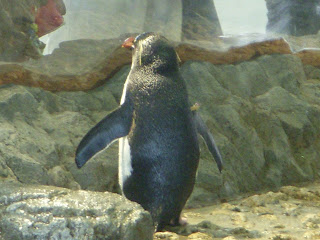Better known than Kobe Animal Kingdom is the Osaka Aquarium. It is frequently said to be one of the largest aquariums in the world, though I get the impression that it is no longer in the top ten. Regardless of its relative size, it is an impressive institution.
Nearly all the exhibits at this aquarium replicate a specific ecosystem on the Pacific Rim. The main display area starts out with a Japanese forest, though these Asian small-clawed otters are out of place.
Some Japanese freshwater crabs.
I took this picture of the sea otter display to provide a sense of the general exhibit design. (I was unable to get a good picture of the main inhabitant, but you may be able to just make it out floating in the far back here.) Space is limited from back to front, but the main tanks here are very, very deep. The walkway is built as a downward spiral so that visitors pass by each display multiple times at different depths.
A ring-tailed coati, part of a Panama Bay exhibit.
It had a pit filled with soft substrate, probably to encourage foraging behavior.
A black doradid, an Amazonian catfish.
A capybara.
Three species of penguins were exhibited together: Adélie, gentoo, and king.
The surface of the Great Barrier Reef tank.
The biggest tank of the lot was the Pacific Ocean display, most prominently featuring whale sharks.
I had heard that there were manta rays in this tank, but, to my disappointment, that no longer seems to be the case. However, many other species of sharks were present, along with schooling actinopterygians.
Eagle ray photobomb.
Another tank contained a group of oval squid. Octopuses and cuttlefish are common in aquariums in my experience, but this was one of the few times I've seen captive squid.
Even more exciting was the ocean sunfish, the largest living actinopterygian (and probably one of the most unusual-looking).
At the bottom of the Great Barrier Reef tank, I witnessed some cleaner wrasse doing their job on one of their clients (which I couldn't identify).
The end of the spiral walkway gave way to a series of jellyfish tanks. These are Gonionemus vertens.
Ctenophores!
A couple of flame jellyfish.
Next came a series of displays on arctic sea life. Of note were the sea angels, swimming sea slugs well known in Japan but unfamiliar elsewhere. In fact, they served as inspiration for a couple of Pokémon. Less angelic-looking but no less interesting was this lumpsucker.
A ringed seal. Its exhibit had ice grains periodically dropping from the ceiling to simulate snow, which was neat.
Some of the last exhibits before the gift shop included a shark touch pool and these rockhopper penguins.
The legendary giant isopod plushies are real.
Yes, that's a bandanna with a feathered Tyrannosaurus on it.
The design printed on the gift bags they give you. As far as I can tell, all of the animals pictured here are species that are or have been on display at the aquarium. Can you name them all?



































Great blog post! I really liked your pictures. I went to this aquarium in January 2025 and these pictures reminded me of the fun experience:)
ReplyDeleteThank you! Glad you enjoyed the aquarium (and the post). It's been a decade since my visit; I'd love to see it again!
Delete